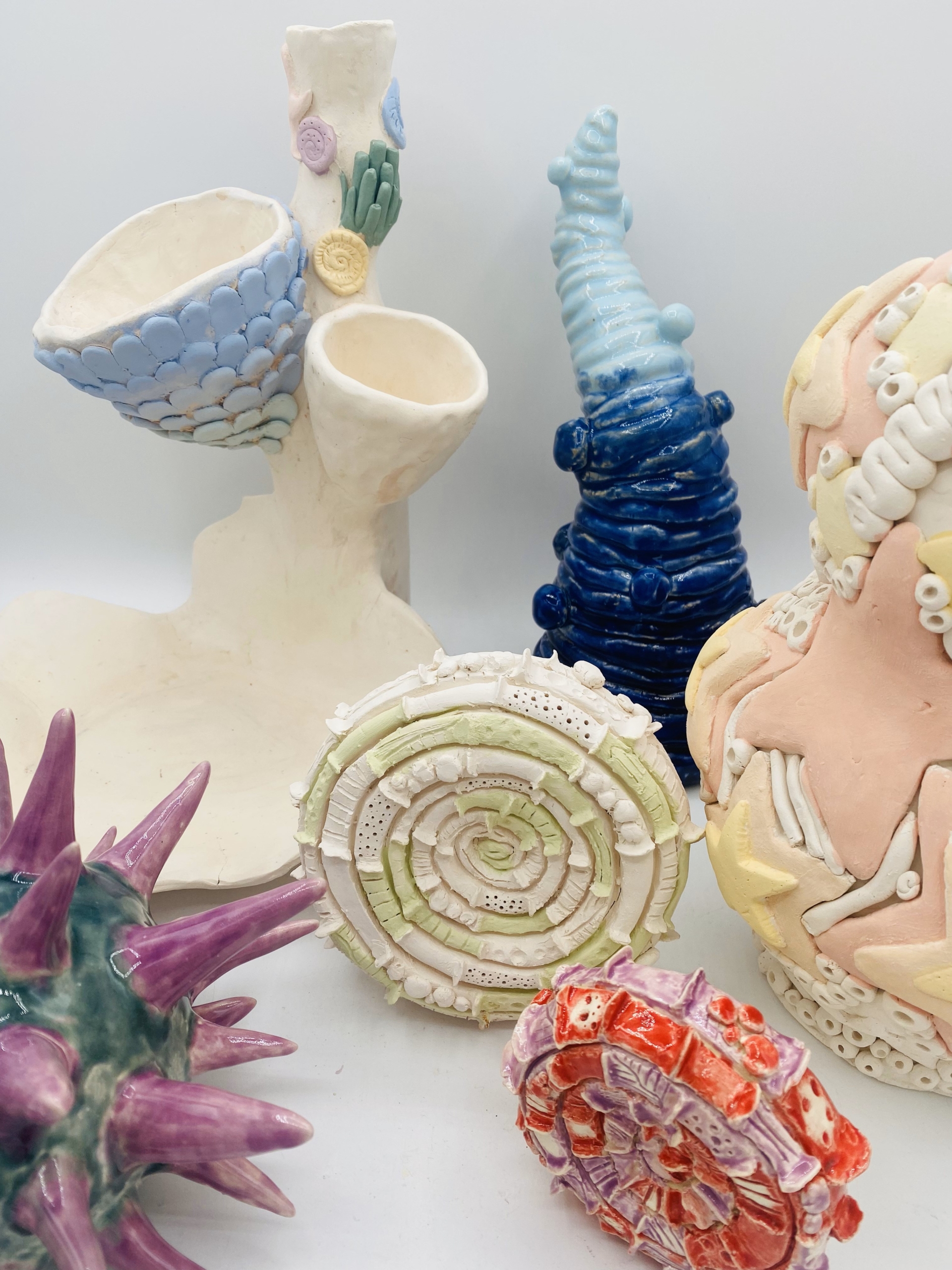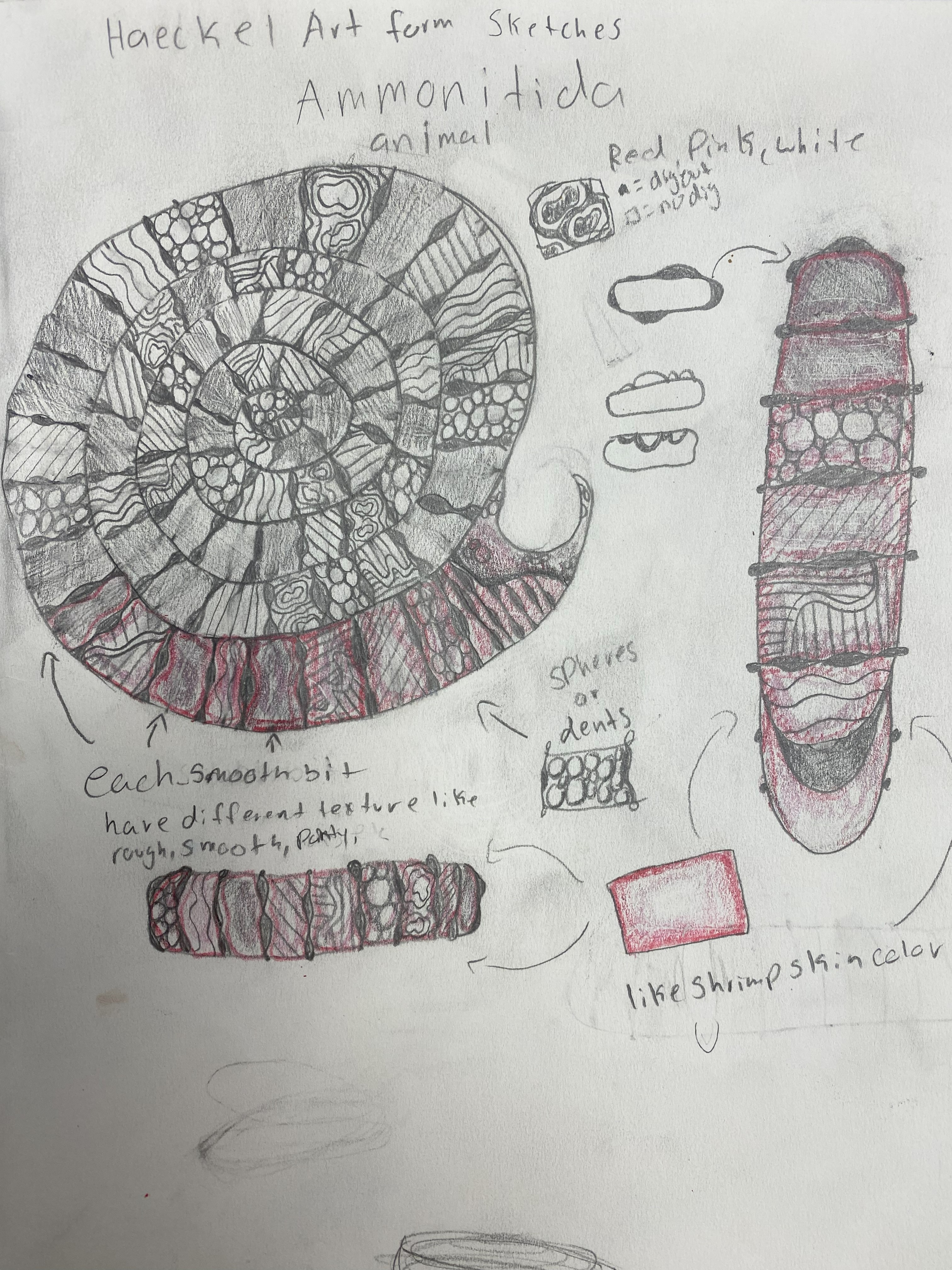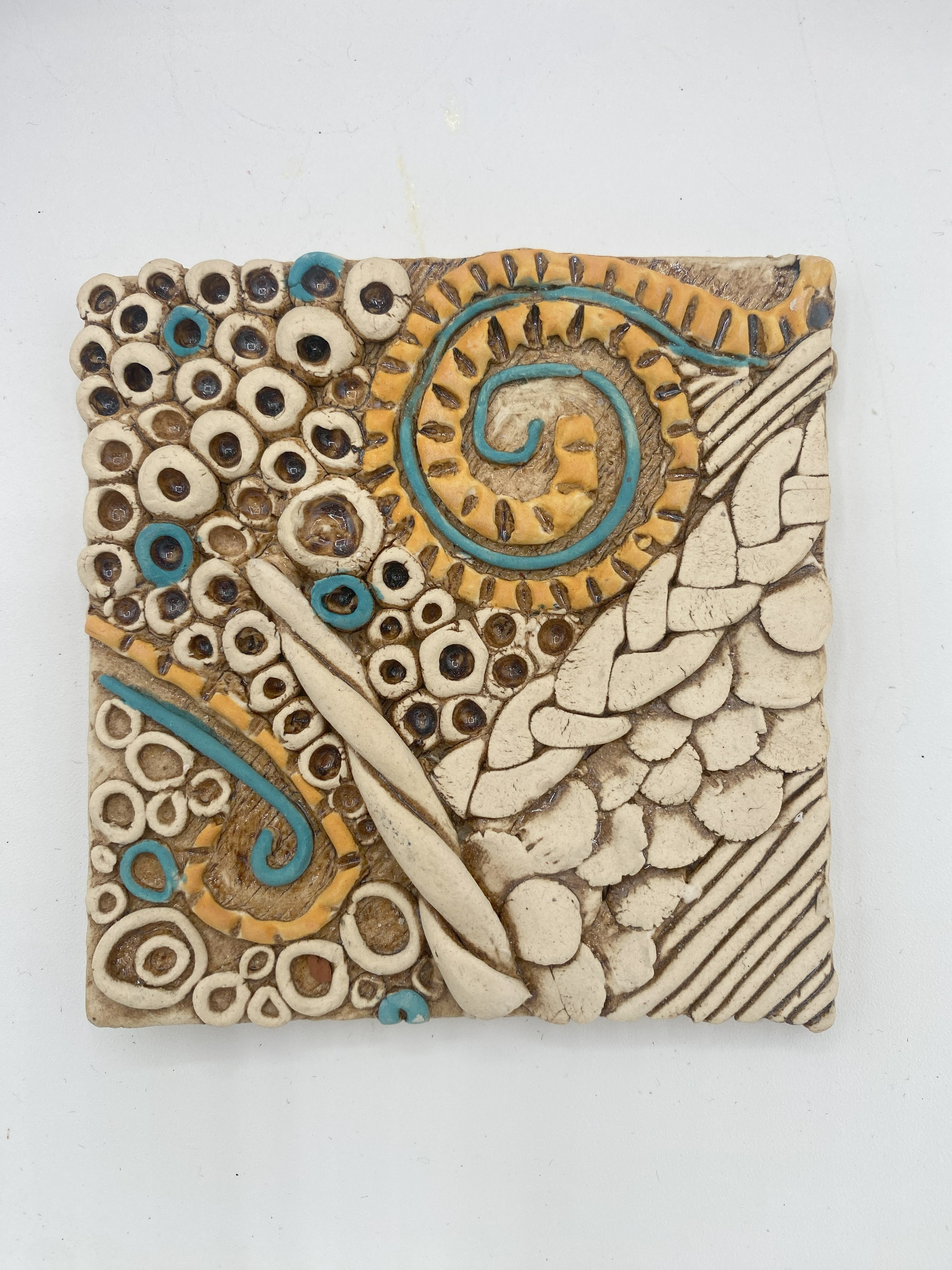Amorphous Coil Vessels

Meet The Teacher: Jordan Anson
I teach Ceramics I & II and am also the Art Club Sponsor at Rogers High School in Northwest Arkansas. My classroom is built on connection and collaboration- it's a space where students of all abilities come together to problem solve and everyone can feel supported, inspired, and excited to make with their hands!
Project Description
Students will create an amorphous vessel by researching a microscopic organism from Ernst Haeckel's Art Forms in Nature and translating its fluid, organic shapes into a 10"-tall coil-built form. This project invites students to blend scientific observation with creative clay construction, forging a deeper connection to natural forms and nature.
Materials
- 3-4 lbs of stoneware clay
- Rib
- Needle Tool
- Sponge
- Wooden Tool
- Slip-trailing bottle
- Texture tools
- Paper
- Pencil
- Slip
- Digital access to Ernst Haeckel's Art Forms in Nature Illustrations
Grade Level
High School
Difficulty
Advanced
Student Hands-On Time
6-8 class periods
Teacher Prep Time
3-4 hours
Project Cost / Cost Per Student
4.95
National Core Arts Standards - Visual Arts
- Creating - Generate and conceptualize artistic ideas.
- Creating - Organize and develop artistic work.
- Creating - Conceiving and developing new artistic ideas and work.
- Presenting - Select, analyze, and interpret works for presentation.
- Presenting - Develop skills for artistic presentation and exhibition.
- Responding - Perceive and analyze artistic work.
- Responding - Interpret intent and meaning in artwork.
- Responding - Evaluate and critique based on aesthetic and technical qualities.
- Connecting - Relate artistic ideas to historical, cultural, and social contexts.
- Connecting - Connect personal experiences with artmaking and meaning.
21st Century Skills
- Critical Thinking & Problem-Solving
- Creativity & Innovation
- Communication
- Collaboration
- Information Literacy
- Initiative & Self-Direction
STEAM Education
- Science
- Arts
Differentiations and Accommodations
Differentiation
IEP
Accommodation
Break tasks into smaller steps with checklists. Provide sentence starters or graphic organizers for sketching and artist statements. Allow extended time for both building and written reflection. Offer one-on-one or small group check-ins during coil-building stages. Give access to pre-rolled coils or textured stamps as needed.
Differentiation
Advanced Learners
Accommodation
Encourage exploration of asymmetry, non-functional form, or mixed surface techniques. Offer the option to incorporate underglaze painting or carving inspired by their organism. Invite them to explore hanging or multi-vessel structures (if time allows).
Differentiation
Struggling Learners
Accommodation
Simplify Objectives: Focus on one or two key goals (e.g., building a strong form with coils and using one texture inspired by their organism).Use templates and tracers: Provide silhouette guides for shaping the base of the vessel or offer simplified organism visuals to narrow down choices.Guided Sketching: Ofer partially completed sketch prompts or outlines they can build on (e.g., "Add your texture here," or "Circle where your form will curve").Small Wins: Build confidence with early success- start with the texture tile experiment to help them feel capable before diving into their vessel.Frequent Check-Ins: Schedule daily touchpoints to check progress, clarify expectations, and encourage effort.Peer Pairing: Pair with a supportive peer who can encourage and model next steps without taking over.
Learning Objectives: Knowledge
Students should be able to: 1.) Identify and describe the influence of microscopic organisms on form and surface design. 2.) Use coil building techniques to construct a ceramic vessel with structural integrity and intentional design. 3.) Apply texture and surface decoration techniques (e.g., carving, stamping, slip-trailing) that reflect their chosen organism's visual characteristics. 4.) Make intentional design choices regarding form, scale, texture, and surface to express a connection between science and art. 5.) Reflect on their creative process and articulate the connections between research, design, and final product.
Learning Objectives: Skills
Technical Skills: 1.) Coil-building construction: Building a structurally sound vessel using hand-building techniques. 2.) Surface design application: Using carving, stamping, and/or slip-trailing to add thoughtful decoration. 3.) Clay texture exploration: Experimenting with tools and techniques to mimic natural surfaces.Design and Creative Thinking Skills: 1.) Translating 2D inspiration into a 3D form: Interpreting visual reference (Haeckel illustrations) into functional or sculptural vessels. 2.) Design Planning: Sketching and conceptualizing form, function, and decorative elements. 3.) Problem solving in form: Making structural or design decisions during the building process. 4.) Visual Storytelling: Communicating inspiration through visual elements.Research & Observation Skills: 1.) Scientific observation: Analyzing the structure, pattern, and texture of microscopic organisms. 2.) Research application: Applying understanding of biological form to ceramic design.Reflection & Communication Skills: 1.) Verbal and written reflection: Articulating connections between their inspiration, design choices, and artistic outcomes. 2.) Critique participation: Giving and receiving feedback through peer discussions or portfolio reflections.
Learning Objectives: Attitudes/Values
Curiosity and Wonder: 1.) A sense of fascination with the natural world, especially with forms that are typically unseen or overlooked. 2.) An openness to explore unusual sources of inspiration and let science inform art.Appreciation for Nature. 1.) Respect for the complexity and beauty of organic life forms. 2.) An understanding that nature can be a powerful, sustainable source of creative inspiration.Patience and Persistence. 1.) Recognition that building a detailed form takes time, careful planning, and the willingness to refine ideas. 2.) A growth mindset: learning from trial and error during both construction and decoration phases.
Formative Assessment
An in-progress critique will take place to guide decision making and certain criteria will be graded such as:Connection to Organism- how much influence and integration of the chosen organism.Coil Construction- attention to form and craftsmanship.Form Development- Unique, expressive form that reflects amorphous qualities.Surface Texture and Detail- Inventive and purposeful surface work that elevates the vessel.Artistic Risk-Taking: Pushed boundaries of form, texture, and concept creatively.Reflection & Planning: Deep research and detailed design development.
Summative Assessment
A final rubric will include the same criteria as the formative assessment, so students are guided to expectations before they complete their forms. This will measure how well students met the objectives of the lesson and expressed their creative vision through their final product.Connection to Organism- how much influence and integration of the chosen organism.Coil Construction- attention to form and craftsmanship.Form Development- Unique, expressive form that reflects amorphous qualities.Surface Texture and Detail- Inventive and purposeful surface work that elevates the vessel.Artistic Risk-Taking: Pushed boundaries of form, texture, and concept creatively.Reflection & Planning: Deep research and detailed design development.
Reflection and Discussion
What about your organism first caught your attention? -How did you translate a microscopic or organic form into a 3D structure? -Where do you see the influence of nature most clearly in your design? -How does your texture reflect the qualities of the organism you chose? -Did you take any creative risks in this project? How did they go? -What have you learned about your creative process through this project?
Lesson Activities
Introduction & Inspiration
Presentation: Show Ernst Haeckel's Art Forms in Nature illustrations and discuss the concept of amorphous forms. Discussion: What makes a form "amorphous"? How do microscopic organisms challenge our ideas of beauty and design?
Research & Observation
Students choose a Haeckel illustration and research the organism it represents (e.g., species name, environment, texture, movement). Students will build an understanding of biological structure and surface qualities to guide vessel design.
Sketching & Planning
Students sketch vessel form ideas inspired by their chosen organism. Prompts: What form will the vessel take? How will you incorporate texture or movement from the organism? What mood or impression do you want to convey?
Construction
Demo: Teacher shows advanced coil-building techniques and how to sculpt organic, asymmetrical forms. Studio Work: Students build vessels using coils, adjusting shape and form as needed while staying true to inspiration. Checkpoints: Periodic check-ins to assess structural integrity and form development.Mini Lesson: Coil Texture Tile Exploration Objective: Experiment with coil-building techniques to discover creative ways to add texture and form inspired by microscopic organisms. 1.) Create your Base Tile Roll out a small slab of clay (4x4 in) with thickness 1/4 inch. This will be your test surface2.) Build with Coils Roll and shape a variety of coils. Try at least 4 different styles -Tight spiral -Layered or stacked -Flattened ribbon -Looped or braided -Pointed, pinched, or carved variations Score and slip each coil before attaching to your tile.3.) Add Texture -Use tools or found objects to add surface texture into or around your coils. -Think about how these textures could connect to the species or form you're researching.4.) Explore & Experiment -This is a place to try ideas before you build your vessel- don't worry about perfection! - Push the limits: layer coils, stretch forms, carve into the surface. - Fire in kiln and use as a test tile for glaze experimentation as well.
Texture & Surface Decoration
Apply surface techniques inspired by the organism- carving, stamping, piercing, slip-trailing, etc. Use decoration to reinforce the connection between organism and vessel design.
Reflection & Critique
Written reflection: Students respond to prompts connecting their research to their creative process. Peer Critique: Group or partner-based feedback on form, creativity, and craftsmanship.
Finishing & Display
Prep for Kiln: Dry, bisque fire, and glaze as needed (or leave raw if intentional) Exhibit in a gallery-style display with artist statements describing their inspiration and design choices.
Step-by-Step Instructions
Step 1
1. Choose your inspiration through Ernst Haeckel's Art Forms in Nature.

Step 2
2. Sketch & Plan- Create 2-3 concept sketches of your vessel.

Step 3
3. Texture Tile Experiment (Mini Lesson) Use a small slab or tile to test different boil-building and texture ideas.
Step 4
4. Build the base of your vessel Roll a slab and cut out a shape that will form the very base of your vessel. Thickness must be at least 1/4". Keep your shape organic, not perfectly round or geometric.
Step 5
5. Begin Coil Construction Roll coils and stack to slip and score to build the height and form of your vessel. Add coils one at a time, blending inside or outside as needed. Check your sketch regularly to stay true to your design. As you build, gently shape your form outward, inward, or organically, making sure your slip and score your coils either on the interior walls, exterior walls, or straight on top the previous coil to form your shape.
Step 6
6. Add Texture & Surface Details Use tools to carve, press, or add textures that relate to your organism. Add coils decoratively as raised textures or structural elements.
Step 7
Refine & Finish Smooth or emphasize areas as needed. Double-check that your piece is structurally sound. Let your vessel dry completely before bisque firing.
Step 8
Reflect & Write Complete your Amorphous Vessel portfolio questions (see attachment)


